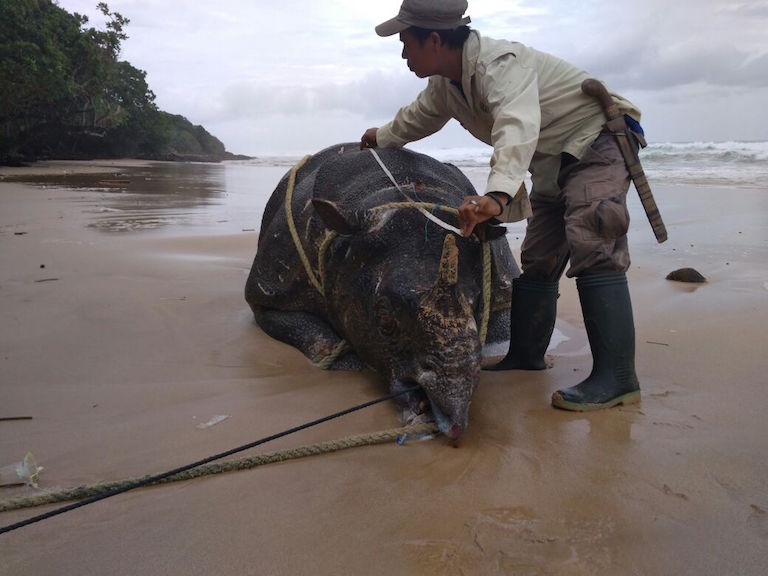- Officials from Indonesia’s Ujung Kulon National Park announced Thursday that two new Javan rhino calves were born this year.
- An adult male, estimated to be around 30 years old, was found dead in the park this week. Officials have found no indication the death was due to poaching, poison or acute infection.
- Ujung Kulon is the sole remaining habitat of the species. With two births and one death, the official population estimate now stands at 68.
With the birth of two new Javan rhino (Rhinoceros sondaicus) calves this year, the population of one of the world’s most endangered mammals continues to show signs of slow but stable growth, Indonesian officials announced on April 26.
Following the death of an adult male this week, believed to be due to natural causes, the known global population of the critically endangered species now stands at 68 individuals.
The newborn calves were spotted on camera traps in Indonesia’s Ujung Kulon National Park, home to the sole remaining population of Javan rhinos. Video from February shows two different mothers, affectionately known as Puri and Dewi, accompanied by their babies. The sex of the calves is still unknown, and they are yet to be named.
“We were very excited about the births,” Mamat Rahmat, chief of the park, told reporters in Jakarta. “We hope the president and the [environment] minister could come and give them names.”

Park officials also announced that park rangers found an adult male rhino dead on one of the park’s beaches on the morning of April 23. At present, officials believe the rhino, who was around 30 years old, died of natural causes.
“There was no sign of the rhino consuming garbage, and there were no indications of bruising on its body or any forms of poaching,” Rahmat said. “At that age, it’s considered to be pretty old.”
None of the rhino’s body parts were missing, indicating that poaching was not the cause of death, and a necropsy conducted on April 24 found no signs of poisoning or acute infection. Authorities are continuing to carry out tests on tissue samples to pinpoint the cause of death, Rahmat said.
From a confirmed population of 67 individuals in February, the tally of Ujung Kulon’s rhinos now stands at a minimum of 68: 29 adult males, 24 adult females and 15 juveniles.
“We’re glad that the birthrate of the Javan rhino is still higher than the mortality rate,” Rahmat said.

Despite this positive trend, the species still faces a number of dangers. Once found throughout Southeast Asia, Javan rhinos are now confined to a single park at the westernmost tip of Indonesia’s Java Island. In addition to the threat of disease, poaching and other human incursions, recent research indicates that a large tsunami could wipe out virtually the entire species.
Ujung Kulon National Park stands in the shadow of an active volcano, Anak Krakatau, that emerged from the devastating 1883 eruption of Krakatoa. That eruption caused a catastrophic tsunami that inundated the Ujung Kulon coast.
Experts agree that moving some of the park’s rhinos is critical for ensuring the long-term survival of the species. Indonesian authorities and wildlife experts have since 2015 been scouting a second site in which to establish a new population of Javan rhinos. The current shortlist includes locations in western Java, but there have also been calls to expand the search to Sumatra Island, which is home to a distant cousin, the Sumatran rhino (Dicerorhinus sumatrensis), also critically endangered.
Banner image: Puri and her baby caught on camera. Image courtesy of the Ujung Kulon National Park Agency.
FEEDBACK: Use this form to send a message to the author of this post. If you want to post a public comment, you can do that at the bottom of the page.
